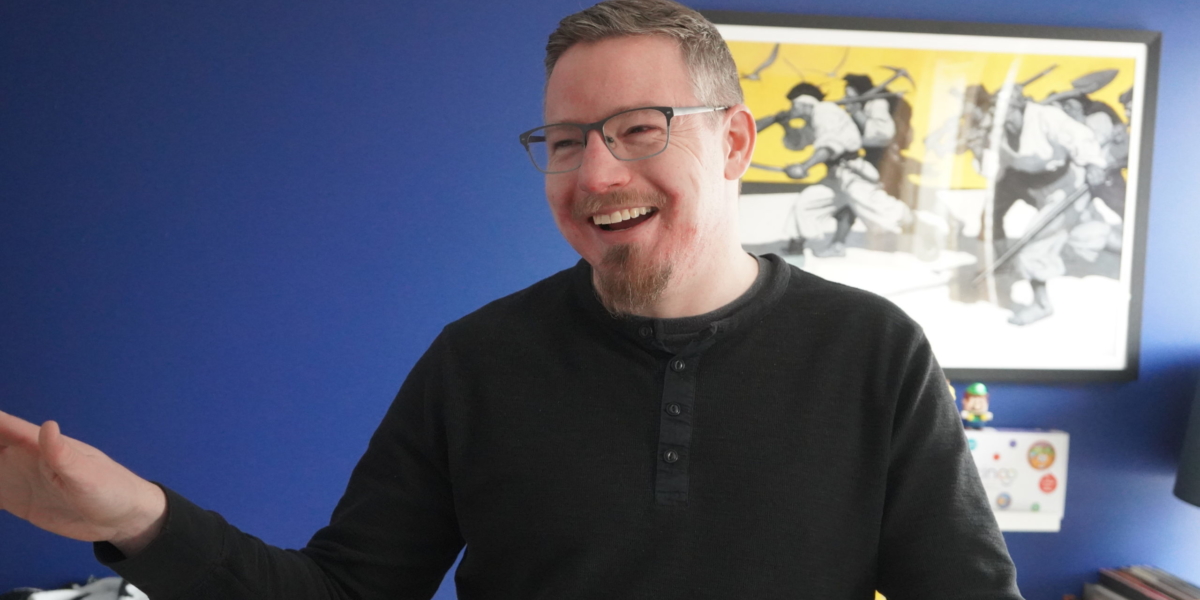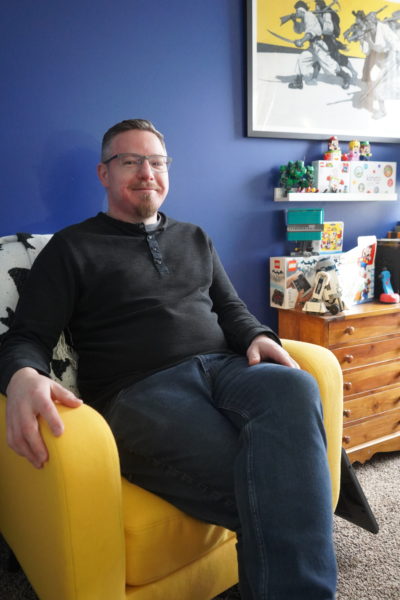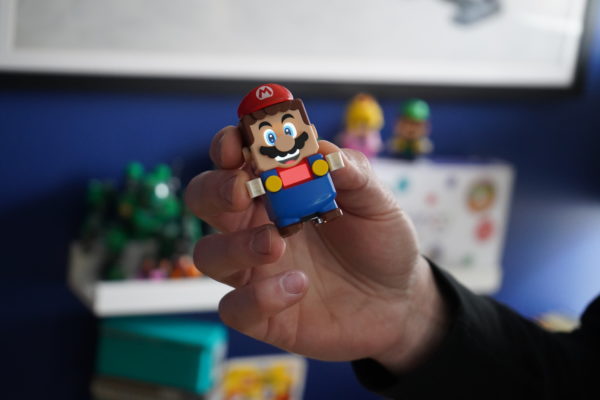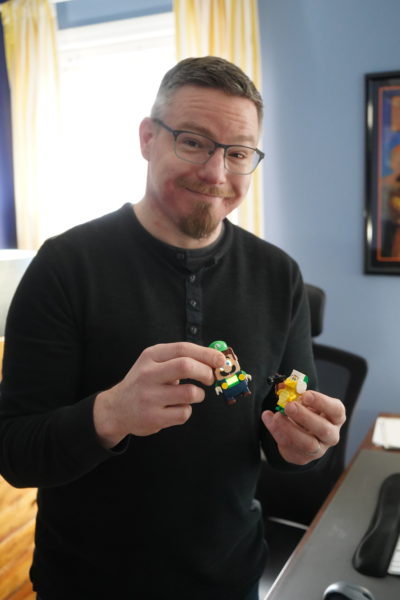
From Lancaster to LEGO, Steve Geist brings illustration skills to product development
Friday, January 13th, 2023
Steve Geist loves creating something from nothing. That process of concept through multiple iterations to finished product or design has been tested time and again during Geist’s career, ever since he graduated from PCA&D in 2006 with his BFA in Illustration. It’s taken him through several career evolutions, from companies like classic LEGO to startup Kinoo. And, through it all, he’s kept his UX and UI bonafides up to date with his own Steve Geist Creative freelance projects.
Now, in his upstairs home studio, surrounded by visual reminders of past projects and Treasure Island illustrations by N.C. Wyeth, Geist is working on his own side projects. Blue walls and a sunshine-y yellow “thinking chair” add pops of background color. In a corner, a painting is testament to the fact that he’s again also picking up his painting: in oils, he says, “because it’s what I mostly studied and it’s what I get the most enjoyment out of.” Just a few feet away, his computer-filled desk also has space for a few LEGO sets, fully assembled.
“No matter the end product, digital or traditional, I’m always bouncing back and forth between the two — even when I was doing paintings in undergrad or high school it was always this back and forth” between methods and techniques,” Geist adds, saying that Photoshop is probably the one tool that he uses most often.
What attracted you to PCA&D as a student searching for an art and design school?
Steve Geist: Location, size, and the ability to explore and play to find your path as an artist.
Did you know right away that Illustration was the major you were drawn to? If not, what was the deciding factor?
SG: I did not know I would focus on Illustration as a major. I thought I would be focusing on Graphic Design. I appreciated the Foundation year’s opportunity to explore different focus areas and techniques. It introduced me to new concepts and showed me that what interested me in art and design was digital illustration, not graphic design per se. But the Foundation year taught me a lot about my voice, the balance of art and design, and my graphic nature.

Steve Geist in his home studio.
You’ve held many positions throughout your career that don’t hold the title of “illustrator,” specifically, and have built a rather non-traditional path. How did you develop these other skills, such as design thinking, that have played a crucial role in your creative life?
SG: I have always thought about art and design and how those processes work. For me, art and design are two very separate things that take similar but different approaches. I have always been process-driven. One thing I love about painting is the canvas-prepping process. This led me to my first professional full-time job out of PCA&D, which happened to be at a product design consultancy firm. I got that job because of my process-driven nature and because I could tell a story with pictures and draw. This position led me to keep exploring this product design world with a digital spin while I attended grad school. That first role and learning the ability to work with cross-functional teams have been the foundation of what I’ve built in my career. I have often looked at each position as a stepping stone to see what skills I can gather to achieve my long-term career goals.
What are some other skills you’ve honed that you find invaluable? Would they be good skills for every creative to familiarize themselves with, no matter the path?
SG: Skills that I have found helpful and everyone should familiarize themselves with no matter the path:
- The basics of project management. Understand how to work in different company environments or manage your own business.
- Design thinking, staying empathetic to your user base. Does this work for the intended audience? Test and iterate.
- Cross-disciplinary collaboration. All projects take a team to come together. Even if you create a graphic novel, you must work with an editor and a printer. You need to know how to speak and understand how to work with developers and project managers and product owners.
- Concept visualization: What is the quickest way to make others understand your idea? Often you need to sell your idea to stakeholders and, to be successful, you need to get an idea across clearly and quickly. Should you draw it? Should you make a PowerPoint, Photoshop mockup, or 3D render?
Looking back at your PCA&D time, were there people who were particularly influential? How did they leave their mark?
SG: Two of my closest friends are from my time at PCA&D, and we were in the same class in the Illustration department. I knew some of the other Illustration majors in the year ahead of me that I was close friends with before joining PCA&D, so we are also still very close. I was introduced to my graduate school program by another classmate who attended the same program; he happened to go before me. So many of the faculty members were influential on me. I became close with a lot of the people in the Illustration department. Jack Martin taught me the process of painting. Eric Fowler showed me concept development and the business side of illustration and introduced me to the depth of the history of American illustration. Between Matt Novak and my children’s literature elective, I built on my passion for developing content for kids. This spurred my goal, leading me to develop kids’ toys and apps.

PCA&D alumnus Steve Geist was involved in the development of this interactive Super Mario toy “from the get-go.”
What’s an example of a career or creative challenge you’ve mastered because of lessons learned at PCA&D?
SG: As artists and designers we are often stuck on perfect work. A creative challenge that I have overcome is being able to look beyond perfection. I learned more about moving quickly and iterating on pieces in my senior year. This has helped me throughout my career. Perfection in my professional work is more of an illusion, and quick iterations are the best thing I have learned from the illustration process — continually building on the last step.
What does an “Experience Design Manager” for LEGO do?
SG: An Experience Design Manager at LEGO is in charge of overseeing the design processing of any LEGO toys that have a “digital layer.” This can be through Bluetooth connection, augmented reality, a companion app, or something else, but the department I was part of was very closely linked to product development. While at LEGO, I oversaw the launch of LEGO Super Mario, LEGO Star Wars Boost Droid Commander, and LEGO Powered UP. So the role combined having an understanding of play design, app development, and interaction design.

Steve Geist holds Super Mario interactive toys that he helped develop with LEGO.
What was your experience like living in a different culture — Denmark — while you were with LEGO? Did the culture itself influence your work?
SG: Living in Denmark has had a significant impact on my life. In Demark, there is a big focus on the division of time between work and life. As creatives and Americans, we often pour ourselves into our work. Living in Denmark gave me a fresh perspective on this. At the same time, I poured myself into my work at LEGO while I was physically there. There was a more significant separation between the parts of your life. This office closed, and you stopped working; this allowed time to recuperate and be your best when present. As for my work, working at LEGO significantly impacted how I approach creative challenges. I suggest everyone who can try different working cultures, big and small companies, to see what feels best for them.
How important has it been to network and make connections throughout your career? Do you have any advice for doing it well?
SG: Networking is massively important, especially in the digital design world. I always wish I was better at it, to be honest, but I’ve found that staying connected with people that you have worked with is essential. Some of the best jobs I’ve had have come from direct recommendations from people I know. Keeping those connections also comes from being someone people want to work with. Even if you have difficulty working with someone, it is best not to burn professional bridges.
